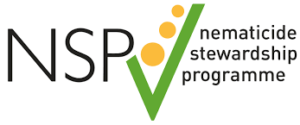By Andy Cunningham
Having a well-planned Integrated Pest Management (IPM) strategy is the cornerstone of any successful potato crop, especially when it comes to Potato Cyst Nematode (PCN).
By incorporating both cultural and chemical controls such as: correct soil sampling; extending crop rotations; using resistant varieties; controlling volunteers; keeping machinery clean; using biofumigants and a granular nematicide, potato growers will be able to keep PCN populations under control.
Soil sampling for nematicides
The first step in a PCN IPM programme is to understand what is present in the field. To achieve this, carry out soil sampling correctly by following the steps below:
- Divide fields into blocks of one hectare or less for sampling
- Use a corer with a 10-15 mm diameter
- Take a minimum of 49 cores/ha in a grid pattern
- Insert the corer to a depth of up to 25 cm
- The entire sample should be sent to the laboratory, no sub-sampling should occur in the field
[For more information visit the AHDB website: https://horticulture.ahdb.org.uk/knowledge-library/pcn-sampling-and-laboratory-guide]
Carry out sampling after the previous crop to understand the burden in the field you wish to plant potatoes in, but also repeat this once the crop has been harvested. This allows you to understand how the population has changed over the course of the growing season and if control methods have been successful.
Understanding what species is present can help make treatment decisions. For example, of the two main species of PCN, Globodera pallida declines more slowly over time, meaning a longer rotation is needed.
It’s important to note that soil sampling isn’t 100% accurate, but still remains the best tool available to provide a population estimate and allow growers to track changes over time.
As PCN can multiply from relatively small numbers to extremely damaging levels within one potato crop, cultural and chemical controls should be considered even with the smallest infestation.
Potato crop rotations to reduce PCN
Using virgin land that has no PCN present is the perfect scenario. However, this is getting increasingly hard to achieve. Therefore, leaving the longest time possible between potato crops is a very effective way of reducing PCN numbers. This is because the pest is unable to complete it’s life cycle in other crops.
It’s recommended that potatoes are grown at least 1 in 7 years and if land is more severely affected this should be extended further.
Using PCN resistant varieties
PCN resistant varieties are available and these help reduce the likelihood of PCN multiplying. However, it’s important to note that they do not stop the PCN that are present in the soil from damaging the crop and causing yield penalties.
Controlling volunteers
Volunteers must be controlled to stop PCN thriving and multiplying during subsequent crops.
- Have a good harvest set up – make sure to have the right webbing on the harvester to reduce returns to the field
- Utilise different crops during rotations to allow the use of different chemistry
- Use sprout suppressants to help minimise the viability of volunteers left in the ground
Keeping machinery clean
Keeping machinery clean, and prioritising this when moving between fields, can help reduce the spread of PCN from highly infected areas to low.
- Plan field harvests, where possible, to avoid moving from highly infested fields to low infestations
- Clean and wash down machinery when moving from field to field to minimise the amount of contaminated soil transfer
- Ensure that any soil from the grading machine is taken back to the field it came from to avoid cross contamination
Using biofumigants to reduce PCN numbers
Biofumigants, such as oil radish, rocket and Indian mustard, have been proven to help manage PCN numbers. These crops are grown for about 8-14 weeks, macerated and incorporated into the soil. Once in the soil they create a toxic gas which helps reduce the PCN.
[Read more on this here: https://archive.ahdb.org.uk/knowledge-library/biofumigation-for-management-of-potato-cyst-nematodes-pcn]
Granular nematicides
In order to keep any PCN population at a manageable level, the use of a granular nematicide treatment will be needed.
Following the NSP best practice steps will ensure that you are using the product properly as part of an IPM programme to protect your crop, the environment and consumer.
- Best practice steps [https://nspstewardship.co.uk/best-practice/]
- Machinery calibration [https://nspstewardship.co.uk/calibration-guide/]
- Field check guide [https://nspstewardship.co.uk/field-checks/]
Inevitably any population can get out of control quickly so it’s important to take the right steps to keep the pest from causing significant damage to crops.

